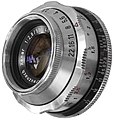Xenar
Xenar is a trademark registered for Schneider-Kreuznach in 1920 for a photographic lens. With the brand a series of lenses from Schneider was named after the pattern of by Paul Rudolph developed 4 lens elements Tessars is constructed. The first Xenars with an aperture ratio of 1: 4 were introduced in 1919, i. H. introduced six years after Schneider was founded. The lens is comparatively compact and has an angle of view of 60 to 62 ° (wide-angle lens). It was produced by Schneider until the late 1990s.
A - small - Xenar on an Edixa camera
Albrecht Wilhelm Tronnier succeeded in making an important improvement to the Xenar in 1935. For the 35mm format he was able to increase the light intensity to 1: 2.8 for wide-angle and normal lenses; for medium format lenses up to 1: 3.5 (DRP 667453, DRP 753329 as well as US patent 2,084,714).
Tele Xenar
Tele-Xenars with focal lengths of 250 and 360 mm for large format photography also have the typical Tessar structure. This did not apply to Tele-Xenare for the 35mm format (see illustration). For the medium format ( Rollei ) Tele-Xenare 1: 4/150 mm, 1: 2.8 / 150 mm and a 1: 4/300 Apo-Tele-Xenar were available.
Individual evidence
- ^ Entry "Xenar" in the German trademark register; available online; Retrieved September 5, 2011
- ^ Kingslake, Rudolf (1889) The History of the Photographic Lens. Academic Publishers Inc. p. 88
- ^ Kingslake, Rudolf (1989) The History of the Photographic Lens. Academic Publishers Inc. p. 279
- ^ Entry "Xenar" in the Schneider-Optik lens database , accessed on September 5, 2011
- ↑ H.-M. Brandt (1956) The Photo Lens. Structure and mode of operation of the most important brand lenses in world production. Friedr. Viehweg & Sohn, Braunschweig. P. 137
- ↑ Tele-Arton - Tele-Xenar. Product brochure in Schneider-Kreuznach's online archive ( memento of October 2, 2011 in the Internet Archive ), accessed on September 5, 2011
- ↑ Peter B. Williams (2001) Medium format cameras: user's guide to buying and shooting. P. 85


